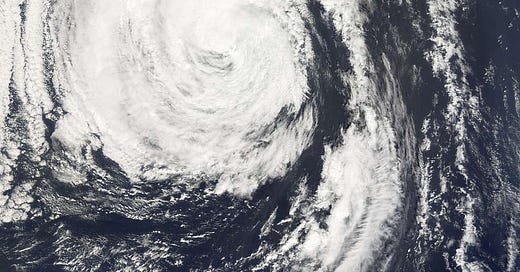hurricane season
We are in the midst of hurricane season, the time of year when low-pressure weather systems grab energy from warm ocean waters, sending violent cyclones across the Caribbean and Atlantic.
And it’s already a bad one.
Despite unexpected calm for most of August and September, Hurricanes Helene and Milton hit the Caribbean and the Southeastern U.S. in quick succession and with a vengeance.
Hurricane Helene made landfall in the late evening of September 26th as a Category 4 hurricane, indicating sustained wind speeds of at least 130 mph and a likelihood for catastrophic damage.
And there was indeed catastrophic damage. Starting in the Big Bend region of Florida, Helene made its way northeast, ravaging neighborhoods, destroying buildings, and flooding streets with 15-foot storm surges.
When Helene reached Georgia on the morning of the 27th, it was a Category 2 hurricane, dumping 12-15 inches of rain and causing catastrophic flooding.
Despite traveling hundreds of miles over land, Helene was still a tropical storm when it reached the Carolinas. Flooding was so intense that the entire city of Asheville, NC was virtually destroyed.
More than 200 people lost their lives. Power outages overwhelmed the region. Homes and business were in ruins.

Not even 2 weeks later, Category 3 Hurricane Milton made landfall. Milton’s winds accelerated sharply just before reaching Florida, and although hurricane impacts were less devastating than expected, 8 people were killed and 3 million lost power.
Hurricanes and tropical storms have always been a dangerous reality for this region of the U.S., but over the past 40 years, hurricane season has worsened, causing more damages and fatalities than ever before.
Part of this could be a direct result of climate change. Sea surface temperatures are warmer and weather patterns are more unpredictable, both of which can cause large, deadly tropical storms.
But there has been a lot of variability in hurricane activity since the early 1900s, making it difficult to measure the direct impact of climate change on storm intensity in the Atlantic.
This spring, the National Oceanic and Atmospheric Administration (NOAA) predicted a worse-than-usual hurricane season, citing warm ocean temperatures and a La Niña climate event. But the first half of the season was uncannily quiet, highlighting the uncertainty in storm forecasting.
That doesn’t mean NOAA was wrong; there is still time for this year’s hurricane season to pick up, and many experts say that this isn’t an unusual effect of climate change. The total number of storms is actually projected to decrease as climate change worsens, while the proportion of hurricanes that are Category 4 and 5 may increase. That’s certainly consistent with the 2024 season so far.
Regardless of the number of hurricanes, it’s evident that destruction and economic damages have skyrocketed over the past 40 years.
Much of this is due to increased population density and urbanization, which places more homes and businesses in vulnerable areas. It also wreaks havoc on coastal ecosystems, leaving communities more susceptible to tropical storms.
As coastal cities were built up, wetlands, mangroves, and natural dune ecosystems were destroyed to make room for apartment complexes, parking lots, and shopping malls.
This type of infrastructure is almost useless at dissipating wave energy from intense storms and preventing flooding from storm surges. Concrete is an impermeable surface, allowing floodwaters to intrude further into coastal communities, washing away homes and businesses.
If instead, natural infrastructure like wetlands, marshes, and coral reefs are protected or rebuilt, they can provide significant protection from hurricanes and tropical storms. Not only can they act as a buffer between the worst storm surge and human settlement, natural barriers can actually slow the energy of storms before they hit coastal communities.
Salt marshes have been shown to reduce annual flood damages by 15%, while coral reefs can dissipate up to 97% of wave energy before it even reaches a coastline. Not only does this keep people safer, it can save millions of dollars in economic damages.
Conversely, degraded natural infrastructure can be further damaged and deteriorated by intense storms like Helene and Milton. Once these ecosystems have been compromised, they are at further risk of destruction.
This is crucial to keep in mind as we move toward more uncertain future hurricane seasons. As ocean temperatures rise and weather patterns change, there is a strong chance we will be faced with more unpredictable hurricane seasons like 2024, and more deadly storms like Helene.
It’s impossible to stop hurricanes or to change their path, but we can improve our defenses by investing in ecological restoration projects and green infrastructure along our coastlines.
Cities are already taking note of this. For example, New York has shifted to prioritize wetlands for stormwater management instead of relying solely on traditional “gray infrastructure.” Initiatives like this are a great start.
Hopefully, coastal communities continue to place economic value on the services we receive from intact, healthy coastal ecosystems. And hopefully, we can lessen the severity of future disasters so we can avoid another Helene.
As the climate crisis produces more uncertain, and potentially deadlier, hurricane seasons, it is critical that we understand the complex relationships between our human impact on the environment, changing weather patterns, and the safety of people and ecosystems.
Resources for those affected by Hurricanes Helene and Milton:
Compilation of government assistance programs: https://www.usa.gov/hurricane-helene
Apply for FEMA assistance: https://www.fema.gov/disaster/current/hurricane-helene
Donate to or volunteer with the Red Cross: https://www.redcross.org/about-us/our-work/disaster-relief/hurricane-relief/hurricane-helene.html



